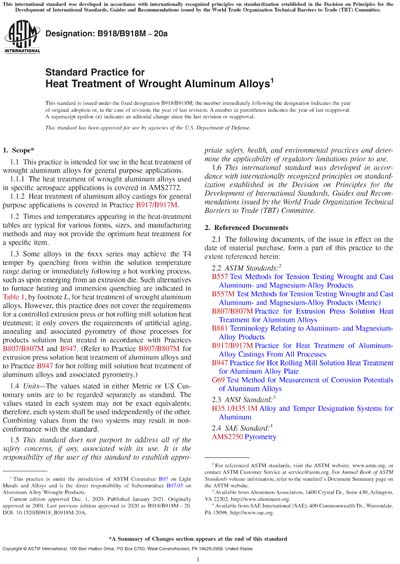Most recent
ASTM B918/B918M-20a
Standard Practice for Heat Treatment of Wrought Aluminum Alloys
1.1 This practice is intended for use in the heat treatment of wrought aluminum alloys for general purpose applications.
1.1.1 The heat treatment of wrought aluminum alloys used in specific aerospace applications is covered in AMS2772.
1.1.2 Heat treatment of aluminum alloy castings for general purpose applications is covered in Practice B917/B917M.
1.2 Times and temperatures appearing in the heat-treatment tables are typical for various forms, sizes, and manufacturing methods and may not provide the optimum heat treatment for a specific item.
1.3 Some alloys in the 6xxx series may achieve the T4 temper by quenching from within the solution temperature range during or immediately following a hot working process, such as upon emerging from an extrusion die. Such alternatives to furnace heating and immersion quenching are indicated in Table 1, by footnote L, for heat treatment of wrought aluminum alloys. However, this practice does not cover the requirements for a controlled extrusion press or hot rolling mill solution heat treatment; it only covers the requirements of artificial aging, annealing and associated pyrometry of those processes for products solution heat treated in accordance with Practices B807/B807M and B947. (Refer to Practice B807/B807M for extrusion press solution heat treatment of aluminum alloys and to Practice B947 for hot rolling mill solution heat treatment of aluminum alloys and associated pyrometry.)
1.4 Units—The values stated in either Metric or US Customary units are to be regarded separately as standard. The values stated in each system may not be exact equivalents; therefore, each system shall be used independently of the other. Combining values from the two systems may result in non-conformance with the standard.
1.5 This standard does not purport to address all of the safety concerns, if any, associated with its use. It is the responsibility of the user of this standard to establish appropriate safety, health, and environmental practices and determine the applicability of regulatory limitations prior to use.
1.6 This international standard was developed in accordance with internationally recognized principles on standardization established in the Decision on Principles for the Development of International Standards, Guides and Recommendations issued by the World Trade Organization Technical Barriers to Trade (TBT) Committee.
ASTM International [astm]

